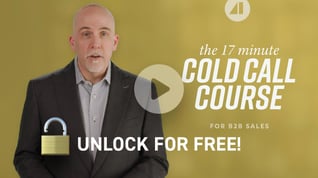Transform your sales approach from overlooked to outstanding by mastering true personalization. It’s not just about using names, but about deeply understanding and aligning with your clients’ unique challenges and ambitions.
Personalization isn’t just using the person’s name, title, or role in an email. Using this easy-to-find information in a communication is the bare minimum. If you don’t go beyond this, the recipient will recognize your message as nothing more than another self-oriented attempt to pitch their solution.
It never helps to position yourself as another desperate salesperson who needs something from the contact. You must differentiate yourself from all the other B2B sales reps who send bland, value-lacking emails that end up being deleted. The ability to stand out from the crowd is an advantage, one that will improve your sales results.
How to Lose an Opportunity before You Create It
One sales team made a call to their dream client. Their contact took their call, and the sales team started to pitch all the ways they could help the company. Several other sales teams explained how their solution is what the client would need. Others shared their global footprint and the resources they would provide their dream client.
The company contact explained they already had suppliers in every category they mentioned, as one might expect from a company that measures revenue in tens of billions. The transactional approach the sales team took with this client worked for them, until it didn’t.
There was no personalization, and the sales team could have been talking to any company. Putting the client’s logo on a slide deck isn’t personalization. It cheapens your conversation. You must do much more than swiping their logo.
To help this sales team, I searched for the dream client’s most recent annual report. Starting with the chairman’s letter to their stakeholders, I carefully read the letter, capturing the company’s initiatives, of which there were many. Armed with many initiatives that the sales team could help accelerate, I turned my attention to the risks the company would need to avoid to succeed in the coming year, removing covid, which shows up in every annual report.
If you will call on gargantuan companies, taking time to read the important sections of the company’s annual report will allow you to truly personalize an email, a phone call, or a face-to-face meeting. The sales team did better on their second try, as they tied almost every initiative to their expertise, without jumping straight to solutions.
How to Win Clients and Alienate Contacts
Another company took another approach. After studying the company, including their annual reports and mentions in the news, they emailed every member of the C-suite early on a Saturday morning. The email recounted the challenges the company was experiencing and the cost savings that would allow them a better strategy. No one could pretend they didn’t see the email, as they were all emailed.
Because these prospective clients had someone in charge of what the sales organization sold, the email was forwarded to that person, who would then call the sender to express their unhappiness, even though this person would not be harmed but would instead have more responsibility. When this approach worked, it was because the email proved the sales organization had done their homework.
Be careful not to use this approach unless you have something important enough or a threat that might cause the client to be harmed by not changing now.
Why No One Reads Your Emails
No one reads your emails, and when they do, they delete them. Thankfully, these are digital messages instead of paper, or we would quickly fill every landfill on planet Earth in short order.
The reason your contacts ignore, mark as spam, delete, or filter out of their inbox is because the email is about you, your company, and your solution. The email is not about your prospective client, their company, or their goals and initiatives.
You are better off doing research on any prospective client you intend to pursue using what we call ValueMail. ValueMail differs from a standard email any sales rep might send. Instead, you use the insights to create value for the contact you are trying to reach.
The overall approach you find on this post is part of a modern sales approach, one with a much higher standard than a legacy approach. It takes more time to do the reading and the research, without which, you have little chance of creating value for your prospective client.
A List of Sources
- The company’s website
- The company’s annual report
- News about the company
- News about the company’s industry
- News about the industry’s headwinds and tailwinds
- News about their competitors
This writer believes that if you are not interested enough to do your homework, you are not serious about acquiring the client. When you do this work, your communication will prove you are serious about the client and their company.
Revolutionizing B2B Sales-Beyond Names and Titles to Genuine Personalization
If you want to sell better, you need to use an approach of true personalization, something more than names and titles. Anyone can use the person’s name and their title.
- Reading and research: Doing the reading and research will transform your understanding of your client, providing you with the ability to provide meaningful communications and interactions.
- One-Up: As a consultative salesperson, you need to know things your clients don’t know and things your competitors don’t know. One of the main advantages is information disparity. As the world changes over the next decade, you will need to be an expert and an authority. See Elite Sales Strategies: A Guide to Being One-Up, Creating Value, and Becoming Truly Consultative.
You can distinguish yourself by using a professional level of personalization, building better relationships, the kind that will ensure you win the client instead of an order. The work you do here will change how you sell and create a preference to buy from you.












